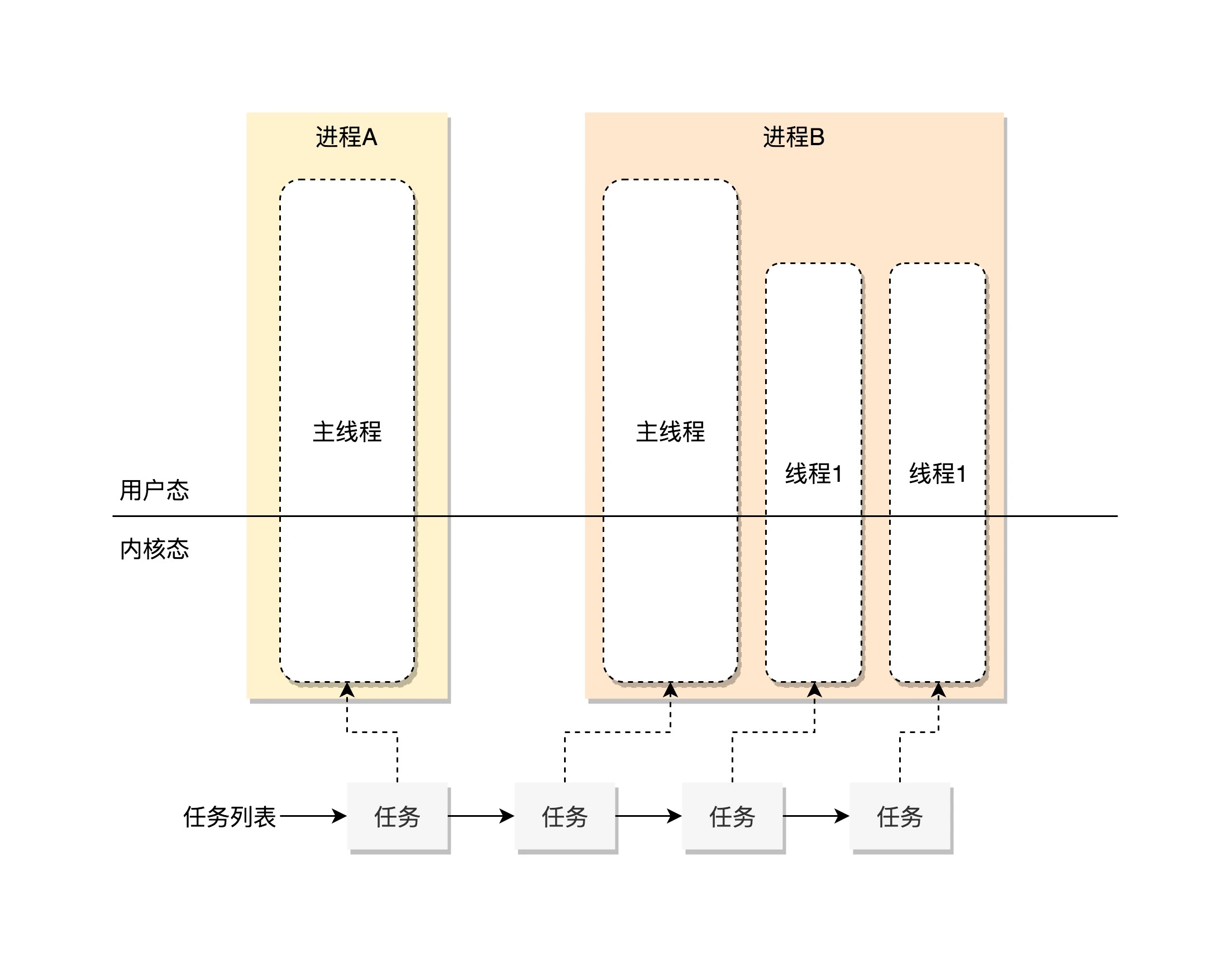Linux 进程管理(二):任务调度
Linux 任务调度
task_struct
在 Linux 里面,无论是进程还是线程,到了内核里面,统一都叫任务(Task),由一个统一的结构体 task_struct 进行管理

这个结构有点复杂,具体可以看相关 代码。
任务 ID
每一个任务都应该有一个任务 ID 作为唯一标识
1 | pid_t pid; |
- pid(process ID): 线程 ID
- tgid(thread group ID):主线程 ID,当前线程就是主线程,那么 tgid 就是 pid
- parent: 指向其父进程。当它终止时,必须向它的父进程发送信号
- children: 表示链表的头部。链表中的所有元素都是它的子进程
- sibling: 用于把当前进程插入到兄弟链表中
- group_leader:指向进程的主线程
通过对比 tgid 和 pid 就可以知道当前 task_struct 是进程还是线程。如果只是想通过 ps 查看有多少进程,可以只展示 pid == tgid 的 task_struct,就不用把所有的都展示出来;如果想要结束一个进程,可以使用 kill 命令结束整个进程而不是线程。
当然也有发送信号给单个线程的情况:可以看 Go Runtime 的抢占式调度的实现
状态
在 task_struct 的状态 code
1 | /* Used in tsk->state: */ |
TASK_RUNNING 并不是说进程正在运行,而是表示进程在时刻准备运行的状态。当处于这个状态的进程获得时间片的时候,就是在运行中;如果没有获得时间片,就说明它被其他进程抢占了,等待再次分配时间片。运行中的进程,一旦要进行一些 I/O 操作,需要等待 I/O 操作完毕,这个时候会主动释放 CPU,进入睡眠状态,在 Linux 中,有两种睡眠状态
- TASK_INTERRUPTIBLE:可中断的睡眠状态。虽然在睡眠,等待 I/O 完成,但是这个时候一个信号来的时候,进程还是要被唤醒,只是唤醒之后不是继续刚才的操作,而是进行信号处理;
- TASK_UNINTERRUPTIBLE:不可中断的睡眠状态。只能等待 I/O 完成,连 kill 信号也会被忽略。除非重启电脑,没有其他办法;
- TASK_KILLABLE:可终止的睡眠状态。进程处于这种状态中,原理和 TASK_UNINTERRUPTIBLE 类似,只不过是可以响应 kill 信号;
- TASK_STOPPED:在进程收到 SIGSTOP、SIGTTIN、SIGTSTP 或者 SIGTTOU 信号之后进入该状态;
- TASK_TRACED:表示进程被 debugger 等进程监控,进程执行被调试程序所停止。当一个进程被另外的进程所监视,每一个信号都会让该进程进入这个状态;
- EXIT_ZOMBIE:一旦一个进程要结束,先进入这个状态,但是这个时候它的父进程还没有使用 wait() 等系统调用来获取它的终止信息,此时进程就成了僵尸进程;
- EXIT_DEAD:是进程的最终状态
状态转换如下所示:
stateDiagram
state "p->state = TASK_RUNNING" as pstate
state "运行" as run
[*] --> sys_fork
sys_fork --> _do_fork
_do_fork --> wake_up_new_task
wake_up_new_task --> pstate
pstate --> TASK_RUNNING
TASK_RUNNING --> run: 分配 CPU
run --> TASK_RUNNING: 时间片使用完毕或被抢占
run --> TASK_INTERRUPTIBLE
run --> TASK_UNINTERRUPTIBLE
run --> TASK_KILLABLE
TASK_INTERRUPTIBLE --> TASK_RUNNING
TASK_UNINTERRUPTIBLE --> TASK_RUNNING
TASK_KILLABLE --> TASK_RUNNING
run --> TASK_STOPPED
run --> EXIT_ZOMBIE: exit
EXIT_ZOMBIE --> EXIT_DEAD
EXIT_DEAD --> [*]运行统计信息
主要包含在下面这些字段中 code
1 | u64 utime; // 用户态消耗的 CPU 时间 |
调度原理
在 Linux 里面,进程可以分为两种:实时进程和普通进程。
- 实时进程:需要尽快执行返回结果的那种
- 普通进程:大部分进程其实都是这种
调度策略
在 task_struct 中 的 policy 用来表示调度策略,有以下一些策略 code
1 | /* |
配合调度策略的,还有优先级
1 | int prio; |
优先级其实就是一个数值,对于实时进程,优先级范围是 0~99;对于普通进程,优先级范围是 100~139。数值越小,优先级越高。
实时调度策略
SCHED_FIFO、SCHED_RR、SCHED_DEADLINE 是实时进程的调度策略
- SCHED_FIFO:先来先执行
- SCHED_RR:轮流调度,采用时间片,相同优先级的任务当用完时间片会被放到队列尾部,以保证公平性,而更高优先级的任务也是可以抢占低优先级的任务
- SCHED_DEADLINE:按照任务的 deadline 进行调度的。DL 调度器总是选择其 deadline 距离当前时间点最近的那个任务,并调度它执行
普通调度策略
SCHED_NORMAL、SCHED_BATCH、SCHED_IDLE 是普通进程的调度策略
- SCHED_NORMAL: 普通进程一般都是这个调度策略
- SCHED_BATCH: 后台进程,几乎不需要和前段进行交互
- SCHED_IDLE: 特别空闲的时候才跑的进程
修改/查看调度策略
1 | !690 # chrt -p 3986612 |
不管是 policy 还是 priority,都是一个变量,真正做调度的是 sched_class
调度策略实现
sched_class 有这些实现 code
1 | extern const struct sched_class stop_sched_class; |
- stop_sched_class: 优先级最高的任务会使用这种策略,会中断所有其他线程,且不会被其他任务打断
- dl_sched_class: 对应 deadline 调度策略
- rt_sched_class: 对应 RR 算法或者 FIFO 算法的调度策略,具体调度策略由 task_struct->policy 指定
- fair_sched_class: 普通进程的调度策略
- idle_sched_class: 空闲进程的调度策略
这里实时进程的调度策略 RR 和 FIFO 相对简单一些,平时遇到的基本上都是普通进程,这里重点分析普通进程的调度,也就是 fair_sched_class。
CFS
在 Linux 里面,实现了一个基于 CFS(Completely Fair Scheduling) 的调度算法。CPU 会提供一个时钟,过一段时间就触发一个时钟中断。CFS 为每个进程设置一个虚拟运行时间 vruntime。如果一个进程在运行,随着时间的增加,也就是一个个 tick 的到来,进程的 vruntime 将不断增大。没有得到运行的进程 vruntime 不变。vruntime 小的进程,会优先运行进程。code
1 | /* |
开始运行的时间减去当前时间,就是这次运行的时间 delta_exec,然后通过 calc_delta_fair 计算得到最终的 vruntime
vruntime += 真实运行的时间 * NICE_0_LOAD / 进程权重
进程每次运行完毕后就会更新 vruntime,然后选择 vruntime 最小的进程继续运行,这将由红黑树完成。
调度队列与调度实体
上面说到的红黑树的节点,应该是包括 vruntime 的,称为调度实体,在 task_struct 中,有这些变量
1 | // task_struct |
进程根据自己是实时的,还是普通的,通过变量将自己挂到某一个调度队列里面,和其它进程排序,等待被调度。如果是普通进程,就将 sched_entity 挂到红黑树上。而真正维护这些队列的就是 CPU,所以每个 CPU 都有自己的 struct rq 结构
1 |
|
对于普通进程公平队列 cfs_rq 中的 tasks_timeline 就是指向红黑树的根节点。调度的时候会先判断是否有实时进程需要运行,如果没有,才会去 CFS 运行队列面找 vruntime 最小的进程运行
1 | /* |
这里的 for_each_class 就是 依次 循环,调用每个调度类的方法。这样整个运行的场景就可以串起来了,在每个 CPU 上都有一个队列 rq,这个队列包含了不同优先级的队列:rt_rq、cfs_rq 等,不同队列实现方式不一样,当某个 CPU 需要找下一个任务执行的时候,会按照优先级依次调用调度类,第一个没有找到才能找下一个调度类的任务,最终找到下个任务继续运行,这样就能保证实时任务的优先级永远大于普通任务。
调度
计算机主要处理计算、网络、存储三个方面。计算主要是 CPU 和内存的合作;网络和存储则多是和外部设备合作;在操作外部设备的时候,往往需要让出 CPU,调用 schedule() 函数
1 | asmlinkage __visible void __sched schedule(void) |
schedule 的主要逻辑都是在 __schedule 里面实现的
__schedule
flowchart
schedule --> __schedule
__schedule -- 1 --> pick_next_task
pick_next_task --> __pick_next_task
__pick_next_task --> pick_next_task_fair
__pick_next_task --> other[class->pick_next_task]
other --> other-logic
pick_next_task_fair --> 1.update_curr
1.update_curr --> update-vruntime
pick_next_task_fair --> 2.pick_next_entity
2.pick_next_entity --> __pick_first_entity
__pick_first_entity -- 2 return next --> __schedule
__schedule -- 3 --> context_switch- 取出当前 CPU 上的任务队列 rq,以及正在运行的进程 curr
- 获取下一个要执行的任务
- 如果是 CFS,就要更新 vruntime,然后取红黑树最左边的节点(vruntime 最小的任务)
- 判断当前进程和下一个要执行的任务是否是同一个任务,如果不是,调用 context_switch
context_switch 主要的逻辑就是上下文切换
- 切换进程空间,即虚拟内存
- 切换寄存器和 CPU 上下文
task_struct 里面有一个 thread 的变量,保留了要切换进程的时候需要修改的寄存器。
进程调度都会走到 __schedule 这里,如果是主动调用 schedule 就是主动让出,那如果不主动让出呢?
抢占式调度
抢占过程
最常见的现象就是一个进程执行时间太长,不主动让出 CPU,这个时候不能一直让这个进程继续运行,需要切换到另外一个进程。衡量这个时间点,就是计算机里面的时钟,每过一段时间(调度周期)就会触发一次时钟中断,这个时候 CPU 会切换任务去响应这个时钟中断,这个时候就可以查看是否需要抢占。时钟中断处理函数主要是 scheduler_tick
flowchart LR
scheduler_tick --> task_tick
task_tick -- 根据 sched_class 判断 --> task_tick_fair
task_tick_fair --> entity_tick
entity_tick --> 1.update_curr
entity_tick --> 2.check_preempt_tick主要的就是 check_preempt_tick,检查是否是应该抢占当前进程
1 | /* |
如果发现当前进程运行过长或者当前进程的 vruntime 大于红黑树中最小的进程的 vruntime,就会调用 resched_curr 标记当前进程为被抢占,而不是真正的抢占,而是打上一个标签 TIF_NEED_RESCHED
另外一个可能抢占的场景就是当一个进程被唤醒的时候。当一个进程在等待 I/O 当时候,会主动放弃 CPU,但是当 I/O 到来的时候,进程往往会被唤醒。这时候是一个时机。当被唤醒的进程优先级高于 CPU 上的当前进程,就会触发抢占。
flowchart LR
try_to_wake_up --> ttwu_queue
ttwu_queue --> ttwu_do_activate
ttwu_do_activate --> ttwu_do_wakeup
ttwu_do_wakeup --> check_preempt_curr到这里,只是把进程标记为被抢占,但是没有发生真正的抢占动作
抢占时机
真正的抢占时机,是让正在运行的进程有机会调用 schedule。
对于用户态进程来讲,从系统调用返回的那个时候,就是一个被抢占的时机。
对于内核态的执行中,被抢占的时机一般发生在 preempt_enable() 中。对于内核有些操作不能被中断,所以一般都会 preempt_disable() 关闭抢占,当再次打开就是一次抢占的机会。还有就是从中断返回的时候返回的也是内核态,这个时候也是一个执行抢占的时机。
参考链接:
- https://mp.weixin.qq.com/s/HFQL5d-C24DKjQbYAQfl8g
- https://mp.weixin.qq.com/s?__biz=Mzk0MjE3NDE0Ng==&mid=2247501576&idx=1&sn=657e1c89d1007a935820d394d64f4035&scene=21#wechat_redirect
- https://zhuanlan.zhihu.com/p/79772089
- https://www.jianshu.com/p/0d90b92000c0
- https://segmentfault.com/a/1190000039367851?utm_source=sf-similar-article
- https://www.cnblogs.com/chaojiyingxiong/p/15799617.html
- http://www.wowotech.net/process_management/scheduler-history.html
- https://www.ibm.com/developerworks/cn/linux/l-cn-scheduler/index.html
- https://www.jianshu.com/p/673c9e4817a8
- https://blog.eastonman.com/blog/2021/02/cfs/
- https://www.kernel.org/doc/html/latest/scheduler/sched-design-CFS.html
- https://time.geekbang.org/column/intro/100024701?tab=catalog